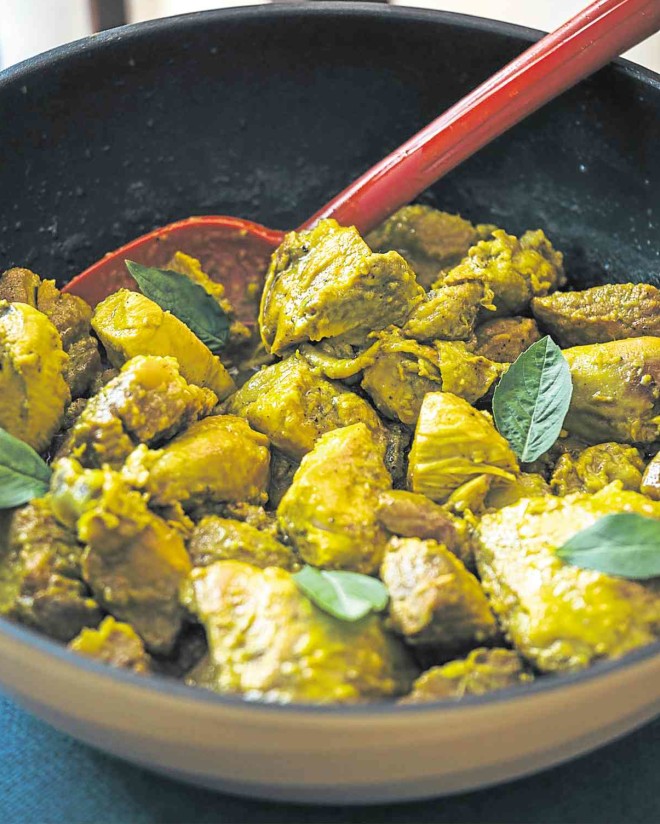
She has tried, savored and enjoyed different versions of adobo but there’s only one variant that she constantly craves: Adobo sa dilaw, more commonly known as Batangas adobo.
Yes, 72-year-old Dulcelin Gourmet matriarch Linda Montenegro Morelos keeps yearning for that stewed dish cooked in vinegar, loads of garlic and turmeric or luyang dilaw. There’s definitely no soy sauce but the inclusion of turmeric brings the adobo flavor to the next level.
Aside from giving it a gorgeous yellowish hue, the luyang dilaw also provides a very distinct “mustardy” aftertaste like a mild vinaigrette dressing.
Adobo sa dilaw is Batangas’ own adobo version. Morelos hails from Taal, Batangas, and the dish is distinctly Taaleño. It uses pork or chicken or both in one dish.
Morelos marinates the meat and all other ingredients in a bowl for at least an hour at room temperature.
For stronger flavor, she lets it stay overnight in the fridge. She sautés the garlic and onions and then adds sliced and pounded turmeric until the oil changes color.
The pork is first put into the wok because it normally takes longer to cook. When the pork is almost tender, the chicken is added and seasoned with fish sauce (patis) to taste.
‘Lola’s’ girl
Morelos learned to cook adobo sa dilaw from Rita Montenegro, the sister of her paternal lola from Taal, Batangas.
also has medicinal value.”
“I grew up with this kind of adobo,” says Morelos, who started cooking the dish at age 12. “If I remember right, it’s still the exact recipe that my lola taught me. The good thing about using turmeric is it also has medicinal value.”
She either uses fresh or powdered turmeric which is available in most wet markets and weekend markets.
She prefers her adobo with just the right amount of sauce, neither too dry nor too wet. There should be just enough sauce to spoon over a mound of rice.
“I don’t like dry adobo unless it’s adobo flakes,” she adds.
Adobong dilaw is also a staple in most family reunions. “That’s what we eat alongside inihaw na liempo, kare-kare and a lot more,” says Morelos.
Morelos grew up under the care of her paternal grandmas and aunts. She was orphaned at six years old—her mom died from tuberculosis when she was four, while her dad died in a freak accident in the province two years after.
“I was spoiled by my lolas and titas,” says Morelos. “I’m also an only child.”
Morelos had fun learning how to cook various dishes from her mentors. When she got married and had children of her own, she studied cooking in Madrid, Spain.
She also had several cooking and baking lessons from local masters like Maur Lichauco, Sylvia Reynoso-Gala, Dorothy Ferreria and Dennis Hipolito.
At present, Morelos, who founded Dulcelin Gourmet, still helps her children Ricky and Mico run the thriving business. Her famous Mango Torte is the all-time bestseller in their restaurant at UP Town Center in Quezon City. She still keeps herself abreast with the latest cooking/baking trends and continues to create wonderful savory dishes and awesome desserts at home.
Adobo sa Dilaw
1 whole chicken (1.4 k more or less), cut into serving portions
1 k pork belly (liempo), sliced into cubes (2×2 inches)
Marinade:
3 heads of garlic, peeled and chopped finely
black pepper to taste
rock salt to taste
½ c white vinegar
¼ c corn oil
1 head garlic, peeled and chopped finely
2 pcs medium-size red onions, peeled and chopped
¼ c peeled and thinly sliced and turmeric (luyang dilaw)
3 thumb-size turmeric, peeled and pounded
¼ c white vinegar
fish sauce (patis) to taste
Garnishing:
Fried fresh basil leaves
Rub chicken with rock salt to remove sliminess. Wash well and let drain for 10 minutes. Wash prepared pork and allow to drain for 10 minutes as well.
Combine ingredients for the marinade in a glass or stainless bowl. This is important as the marinade has vinegar, which can affect the taste of the marinade if an aluminum or plastic bowl is used.
Add pork and chicken, mix well and let stand at room temperature for at least an hour. If stronger flavor is desired, marinate overnight in the refrigerator after an hour of marination at room temperature.
Drain pork and chicken pieces 20 minutes before cooking. Set aside marinade for later use.
Heat oil in a wok and add garlic and onions. Sauté until onions are wilted. Add sliced and pounded turmeric and sauté until the oil changes color. Then add drained pork.
Sauté until pork changes color. Then pour in reserved marinade. Allow to boil without stirring and then simmer until pork is almost tender.
Add chicken and continue to cook until chicken is done. Add ½ c of water if liquid evaporates too quickly. Pour in remaining vinegar and simmer for a few minutes to allow the vinegar to penetrate both chicken and pork. Season with fish sauce to taste.
When ready to serve, transfer pork and chicken to a platter and garnish with fried basil leaves.
E-mail the author at vbaga@inquirer.com.ph